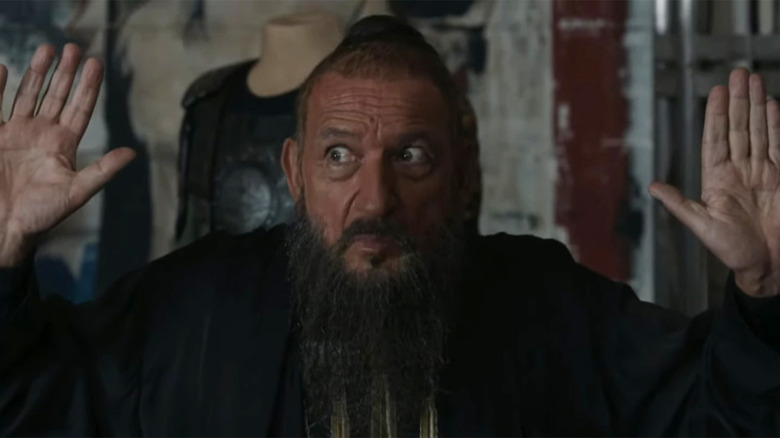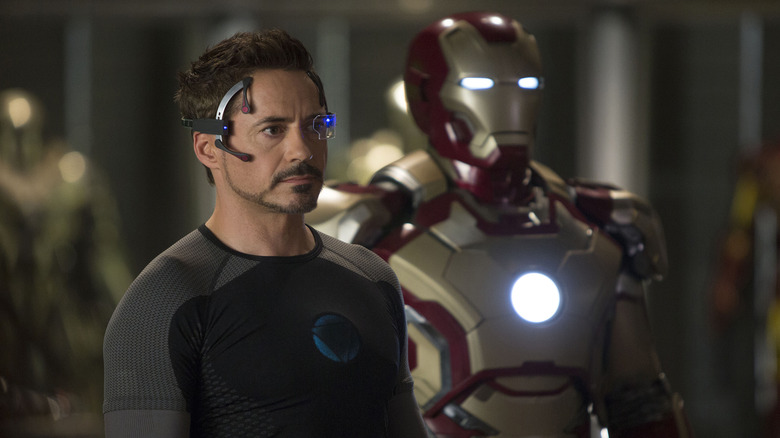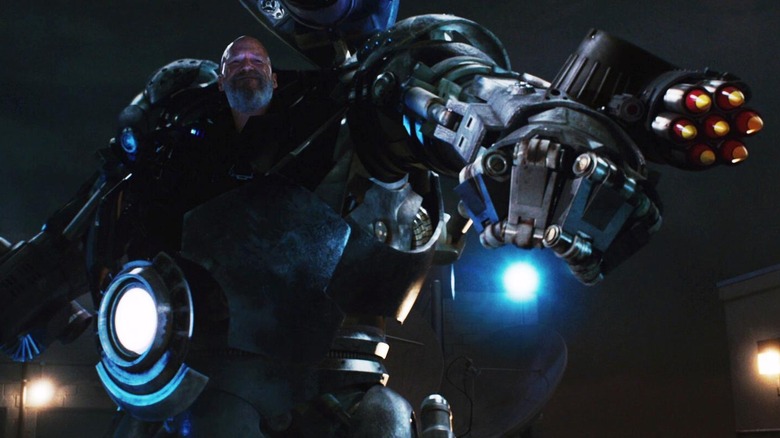The MCU Originally Had Much Different Plans For The Mandarin
The character of The Mandarin first appeared in the pages of Marvel Comics back in 1964, created by Don Heck and Marvel bigwig Stan Lee. In John Coates' 2014 book "Don Heck: A Work of Art," Heck admitted that the Mandarin was more Lee's idea, as he wanted an old-fashioned Fu Manchu-like villain to face off against Iron Man, one of the company's B-list characters. A lot of the cliches and stereotypes embodied by Dr. Fu-Manchu (a villain character from a 1913 pulp novel by Sax Rohmer) transferred directly into the Mandarin. The Mandarin is a supervillain from China and was initially drawn as a racist caricature.
In the original comics, the Mandarin possessed 10 magical rings, salvaged from a crashed alien spaceship. He was one of Iron Man's earliest nemeses. The character has stubbornly remained in the background of Marvel comics for decades.
By 2013, Iron Man had become a hot commodity in American films thanks to the success of "Iron Man" in 2008, "Iron Man 2" in 2009," and "The Avengers" in 2012. It seemed high time that the Mandarin be included in the Marvel Cinematic Universe. To take the edge off the character's stereotyped origins, however, "Iron Man 3" gave the character a twist. He was not a supervillain, but a buffoonish actor in the employ of a secret, secondary supervillain.
In the new book "MCU: The Reign of Marvel Studios" by Joanna Robinson, Dave Gonzalez, and Gavin Edwards, some of the screenwriters of the 2008 "Iron Man" film, Art Marcum and Matt Holloway, intended to put the Mandarin in their movie, thinking it needed as much Iron Man lore as possible. It was their co-screenwriters, Mark Fergus and Hawk Ostby, who fought for the character's exclusion. They felt the Mandarin was dated and cliched.
Only one Iron Man movie
Recall that back in 2008, the success of "Iron Man" and the aggressive ascendency of the superhero genre was hardly a sure thing. Indeed, Iron Man was still considered a lower-tier Marvel hero at the time, not nearly as popular as heroes that already had successful movies like Spider-Man, the X-Men, and the Fantastic Four. As such, the filmmakers behind the 2008 "Iron Man" feature felt that theirs would be both the beginning and the end of the road. Marcum said, "We thought we were making only one Iron Man movie. We had to pack it all into one." As such, the Mandarin was included in the film, a fact that, according to the "MCU" book, was announced at the San Diego Comic-Con way back in 2006.
Screenwriter Holloway recalled a time when the Mandarin was included but was swapped out for a different Iron Man villain called the Crimson Dynamo, the nickname given to various Soviet characters who possessed a suit similar to Iron Man's. These villains were to be included alongside Obadiah Stane (Jeff Bridges), a rival of Tony Stark (Robert Downey, Jr.) who steals the Iron Man technology and builds an outsize battle suit of his own. "Iron Man" was to be a multi-villain affair.
At the time, director Jon Favreau had mandated that they made their Iron Man film as grounded as an Iron Man film could be. It's a broad fantasy film about a man in an indestructible rocket suit, but the tech needed to look as hefty as it could. This decree, however, didn't fit in with the Mandarin. At least not according to screenwriters Fergus and Ostby, who felt the Mandarin was, as mentioned, racist and dated.
Iron Monger and Iron Monger alone
Fergus' and Ostby's pleas were listened to. Kevin Feige, the President at Marvel, had a meeting with Fergus and Ostby and was quoted as saying "Why don't we just save the Mandarin for another day?" They did. The Mandarin was out, and only Obadiah Stane remained.
This was a wise choice, as there are myriad examples of superhero films being bogged down with too many villains. The year before "Iron Man" was released, Sam Raimi's "Spider-Man 3" featured the Sandman (Thomas Haden Church), Venom (Topher Grace), and the Green Goblin (James Franco). That film was a success but wasn't terribly well-received by fans. The same might be said of the 2006 film "X-Men: The Last Stand," which featured two dozen characters all jumbled together. And who could forget Joel Schumacher's 1997 classic "Batman & Robin," which featured the title duo teaming up with Batgirl (Alicia Silverstone) to fight Poison Ivy (Uma Thurman), Bane (Robert Swenson), and Mr. Freeze (Arnold Schwarzenegger)? Too many bad guys, in all of those cases, made for a jumble. Fergus and Ostby would have preferred not to go overboard on their first outing with Iron Man.
As such, the Mandarin and the Crimson Dynamo ideas were cut, and Obadiah Stane, known in the comics as the Iron Monger, was the only villain permitted to remain. Indeed, for the bulk of "Iron Man," Obadiah Stane is a level-headed businessman who is outraged by Tony Stark's abrupt rejection of weapons manufacturing. It wouldn't be until the film's finale that he would appear in an outsize Iron Man suit. That construction made for a cleaner feature and, ultimately, a better movie.
"Iron Man" was a hit. Eventually, it would lead to the 33-film (and counting) Marvel Cinematic Universe.


